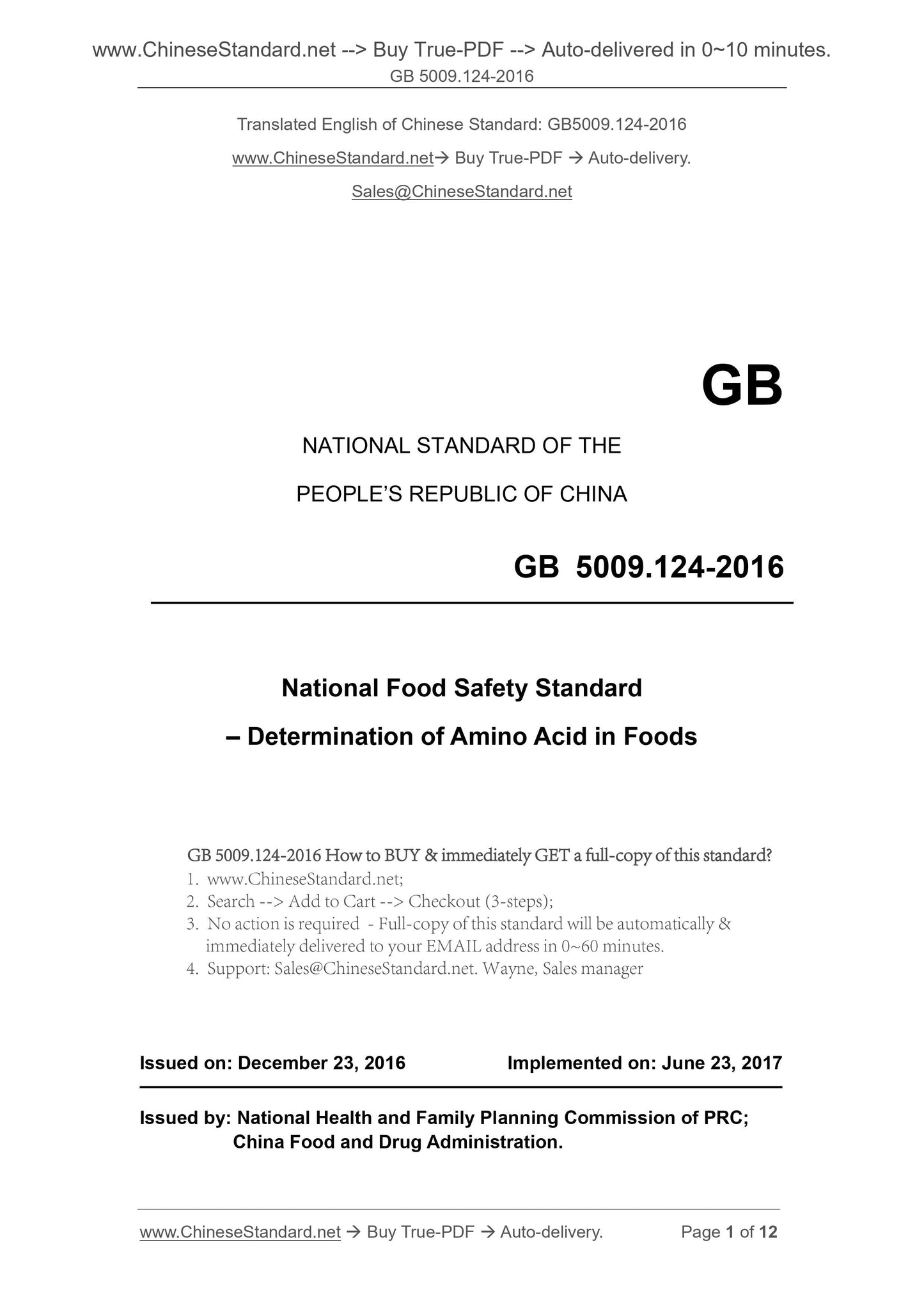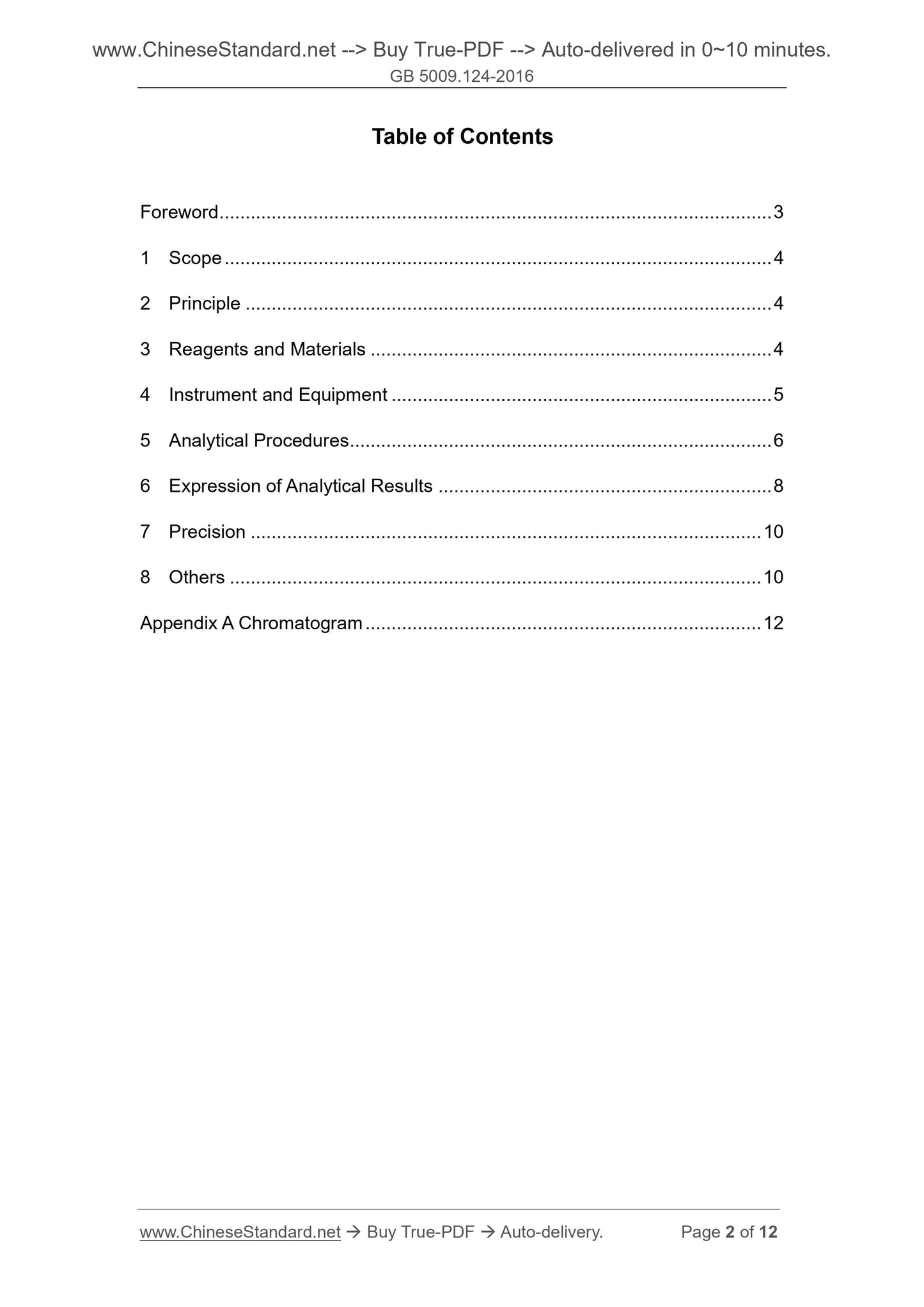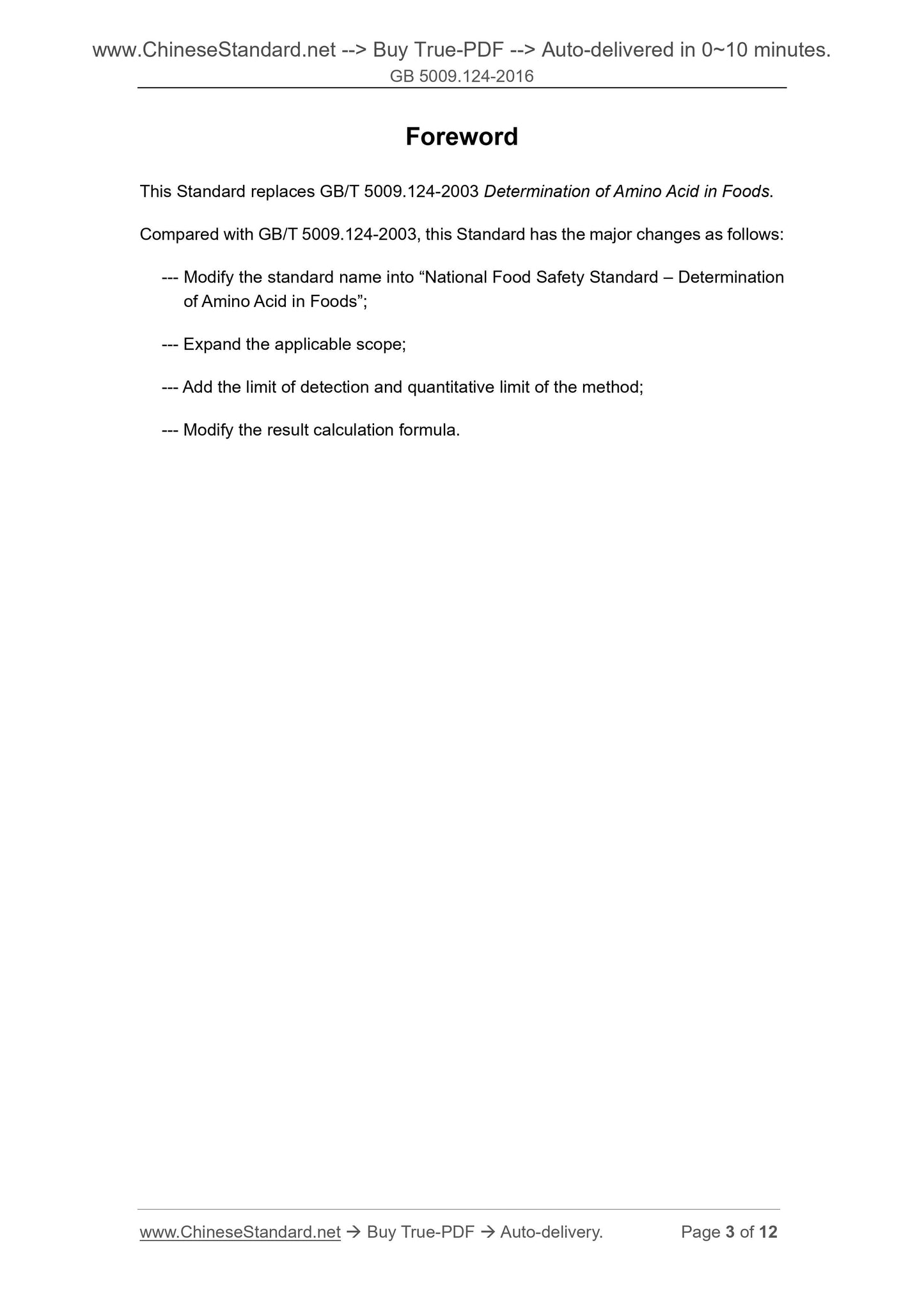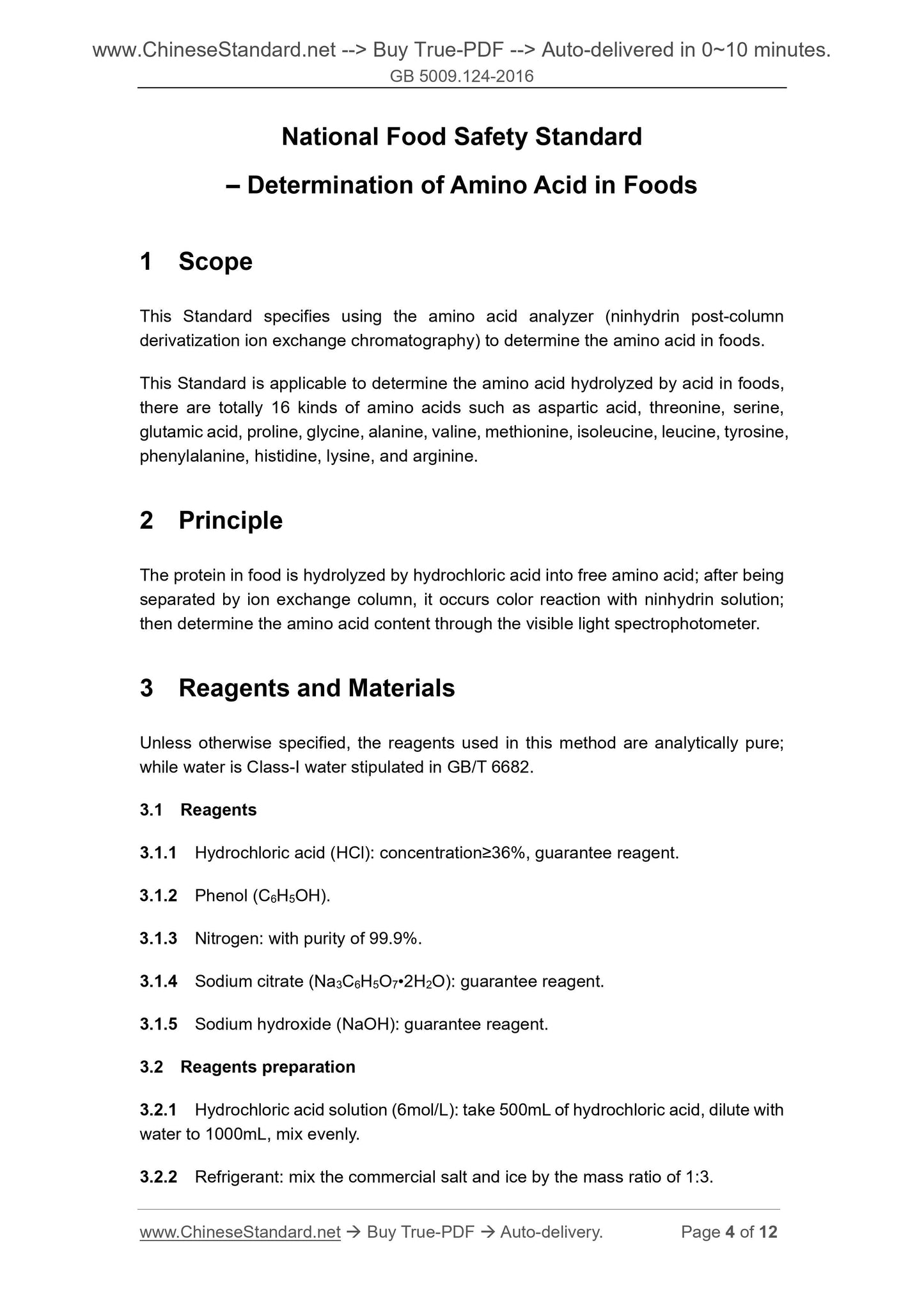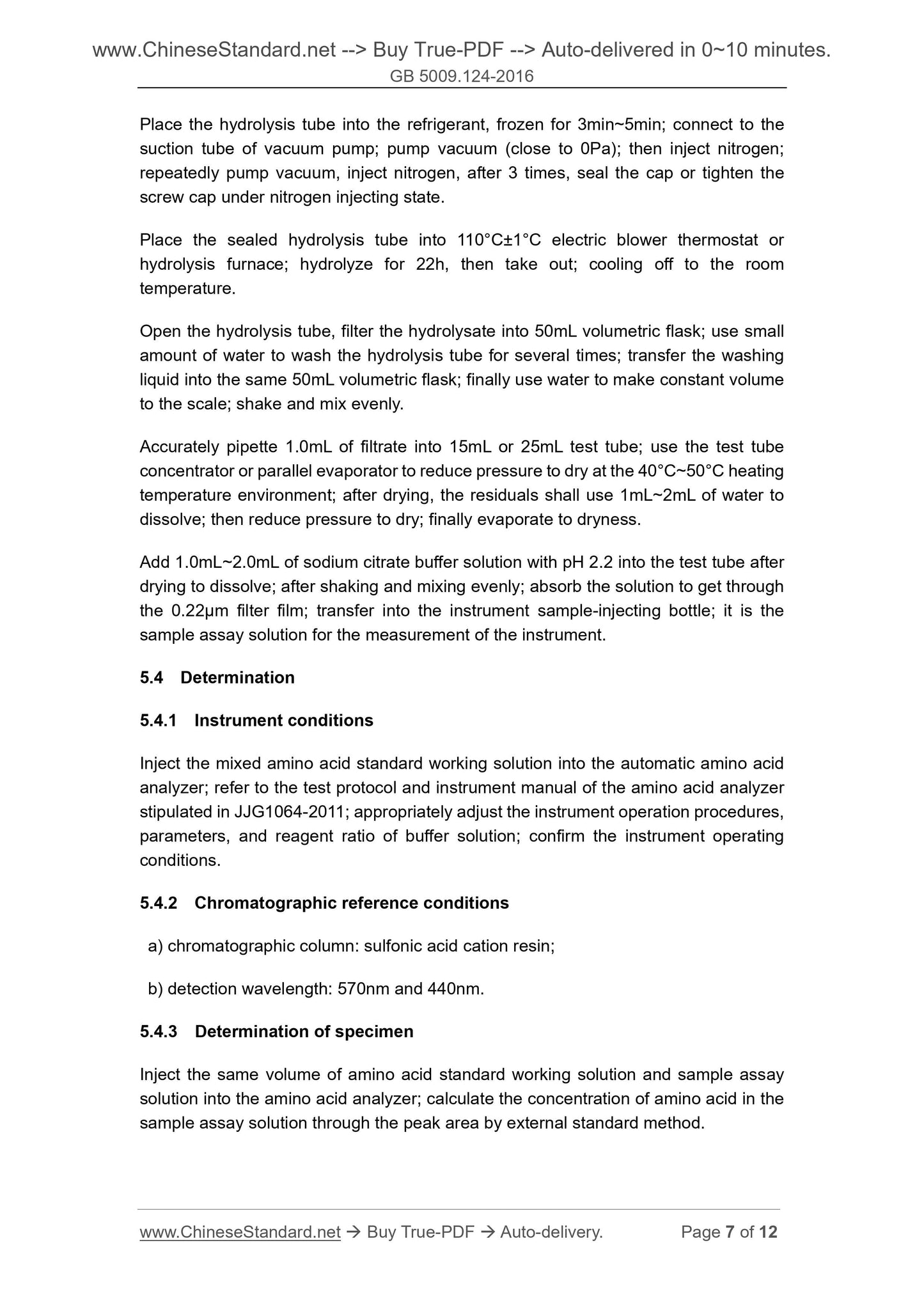1
/
of
5
PayPal, credit cards. Download editable-PDF & invoice in 1 second!
GB 5009.124-2016 English PDF
GB 5009.124-2016 English PDF
Regular price
$85.00 USD
Regular price
Sale price
$85.00 USD
Unit price
/
per
Shipping calculated at checkout.
Couldn't load pickup availability
Delivery: 3 seconds. Download true-PDF + Invoice.
Get QUOTATION in 1-minute: Click GB 5009.124-2016
Historical versions: GB 5009.124-2016
Preview True-PDF (Reload/Scroll if blank)
GB 5009.124-2016: National Food Safety Standard -- Determination of Amino Acid in Foods
GB 5009.124-2016
GB
NATIONAL STANDARD OF THE
PEOPLE’S REPUBLIC OF CHINA
National Food Safety Standard
– Determination of Amino Acid in Foods
ISSUED ON. DECEMBER 23, 2016
IMPLEMENTED ON. JUNE 23, 2017
Issued by. National Health and Family Planning Commission of PRC;
China Food and Drug Administration.
Table of Contents
Foreword ... 3
1 Scope ... 4
2 Principle ... 4
3 Reagents and Materials ... 4
4 Instrument and Equipment ... 5
5 Analytical Procedures ... 6
6 Expression of Analytical Results ... 8
7 Precision ... 10
8 Others ... 10
Appendix A Chromatogram ... 12
Foreword
This Standard replaces GB/T 5009.124-2003 Determination of Amino Acid in Foods.
Compared with GB/T 5009.124-2003, this Standard has the major changes as follows.
--- Modify the standard name into “National Food Safety Standard – Determination
of Amino Acid in Foods”;
--- Expand the applicable scope;
--- Add the limit of detection and quantitative limit of the method;
--- Modify the result calculation formula.
National Food Safety Standard
– Determination of Amino Acid in Foods
1 Scope
This Standard specifies using the amino acid analyzer (ninhydrin post-column
derivatization ion exchange chromatography) to determine the amino acid in foods.
This Standard is applicable to determine the amino acid hydrolyzed by acid in foods,
there are totally 16 kinds of amino acids such as aspartic acid, threonine, serine,
glutamic acid, proline, glycine, alanine, valine, methionine, isoleucine, leucine, tyrosine,
phenylalanine, histidine, lysine, and arginine.
2 Principle
The protein in food is hydrolyzed by hydrochloric acid into free amino acid; after being
separated by ion exchange column, it occurs color reaction with ninhydrin solution;
then determine the amino acid content through the visible light spectrophotometer.
3 Reagents and Materials
Unless otherwise specified, the reagents used in this method are analytically pure;
while water is Class-I water stipulated in GB/T 6682.
3.1 Reagents
3.1.1 Hydrochloric acid (HCl). concentration≥36%, guarantee reagent.
3.1.2 Phenol (C6H5OH).
3.1.3 Nitrogen. with purity of 99.9%.
3.1.4 Sodium citrate (Na3C6H5O7•2H2O). guarantee reagent.
3.1.5 Sodium hydroxide (NaOH). guarantee reagent.
3.2 Reagents preparation
3.2.1 Hydrochloric acid solution (6mol/L). take 500mL of hydrochloric acid, dilute with
water to 1000mL, mix evenly.
3.2.2 Refrigerant. mix the commercial salt and ice by the mass ratio of 1.3.
Place the hydrolysis tube into the refrigerant, frozen for 3min~5min; connect to the
suction tube of vacuum pump; pump vacuum (close to 0Pa); then inject nitrogen;
repeatedly pump vacuum, inject nitrogen, after 3 times, seal the cap or tighten the
screw cap under nitrogen injecting state.
Place the sealed hydrolysis tube into 110°C±1°C electric blower thermostat or
hydrolysis furnace; hydrolyze for 22h, then take out; cooling off to the room
temperature.
Open the hydrolysis tube, filter the hydrolysate into 50mL volumetric flask; use small
amount of water to wash the hydrolysis tube for several times; transfer the washing
liquid into the same 50mL volumetric flask; finally use water to make constant volume
to the scale; shake and mix evenly.
Accurately pipette 1.0mL of filtrate into 15mL or 25mL test tube; use the test tube
concentrator or parallel evaporator to reduce pressure to dry at the 40°C~50°C heating
temperature environment; after drying, the residuals shall use 1mL~2mL of water to
dissolve; then reduce pressure to dry; finally evaporate to dryness.
Add 1.0mL~2.0mL of sodium citrate buffer solution with pH 2.2 into the test tube after
drying to dissolve; after shaking and mixing evenly; absorb the solution to get through
the 0.22µm filter film; transfer into the instrument sample-injecting bottle; it is the
sample assay solution for the measurement of the instrument.
5.4 Determination
5.4.1 Instrument conditions
Inject the mixed amino acid standard working solution into the automatic amino acid
analyzer; refer to the test protocol and instrument manual of the amino acid analyzer
stipulated in JJG1064-2011; appropriately adjust the instrument operation procedures,
parameters, and reagent ratio of buffer solution; confirm the instrument operating
conditions.
5.4.2 Chromatographic reference conditions
a) chromatographic column. sulfonic acid cation resin;
b) detection wavelength. 570nm and 440nm.
5.4.3 Determination of specimen
Inject the same volume of amino acid standard working solution and sample assay
solution into the amino acid analyzer; calculate the concentration of amino acid in the
sample assay solution through the peak area by external standard method.
Get QUOTATION in 1-minute: Click GB 5009.124-2016
Historical versions: GB 5009.124-2016
Preview True-PDF (Reload/Scroll if blank)
GB 5009.124-2016: National Food Safety Standard -- Determination of Amino Acid in Foods
GB 5009.124-2016
GB
NATIONAL STANDARD OF THE
PEOPLE’S REPUBLIC OF CHINA
National Food Safety Standard
– Determination of Amino Acid in Foods
ISSUED ON. DECEMBER 23, 2016
IMPLEMENTED ON. JUNE 23, 2017
Issued by. National Health and Family Planning Commission of PRC;
China Food and Drug Administration.
Table of Contents
Foreword ... 3
1 Scope ... 4
2 Principle ... 4
3 Reagents and Materials ... 4
4 Instrument and Equipment ... 5
5 Analytical Procedures ... 6
6 Expression of Analytical Results ... 8
7 Precision ... 10
8 Others ... 10
Appendix A Chromatogram ... 12
Foreword
This Standard replaces GB/T 5009.124-2003 Determination of Amino Acid in Foods.
Compared with GB/T 5009.124-2003, this Standard has the major changes as follows.
--- Modify the standard name into “National Food Safety Standard – Determination
of Amino Acid in Foods”;
--- Expand the applicable scope;
--- Add the limit of detection and quantitative limit of the method;
--- Modify the result calculation formula.
National Food Safety Standard
– Determination of Amino Acid in Foods
1 Scope
This Standard specifies using the amino acid analyzer (ninhydrin post-column
derivatization ion exchange chromatography) to determine the amino acid in foods.
This Standard is applicable to determine the amino acid hydrolyzed by acid in foods,
there are totally 16 kinds of amino acids such as aspartic acid, threonine, serine,
glutamic acid, proline, glycine, alanine, valine, methionine, isoleucine, leucine, tyrosine,
phenylalanine, histidine, lysine, and arginine.
2 Principle
The protein in food is hydrolyzed by hydrochloric acid into free amino acid; after being
separated by ion exchange column, it occurs color reaction with ninhydrin solution;
then determine the amino acid content through the visible light spectrophotometer.
3 Reagents and Materials
Unless otherwise specified, the reagents used in this method are analytically pure;
while water is Class-I water stipulated in GB/T 6682.
3.1 Reagents
3.1.1 Hydrochloric acid (HCl). concentration≥36%, guarantee reagent.
3.1.2 Phenol (C6H5OH).
3.1.3 Nitrogen. with purity of 99.9%.
3.1.4 Sodium citrate (Na3C6H5O7•2H2O). guarantee reagent.
3.1.5 Sodium hydroxide (NaOH). guarantee reagent.
3.2 Reagents preparation
3.2.1 Hydrochloric acid solution (6mol/L). take 500mL of hydrochloric acid, dilute with
water to 1000mL, mix evenly.
3.2.2 Refrigerant. mix the commercial salt and ice by the mass ratio of 1.3.
Place the hydrolysis tube into the refrigerant, frozen for 3min~5min; connect to the
suction tube of vacuum pump; pump vacuum (close to 0Pa); then inject nitrogen;
repeatedly pump vacuum, inject nitrogen, after 3 times, seal the cap or tighten the
screw cap under nitrogen injecting state.
Place the sealed hydrolysis tube into 110°C±1°C electric blower thermostat or
hydrolysis furnace; hydrolyze for 22h, then take out; cooling off to the room
temperature.
Open the hydrolysis tube, filter the hydrolysate into 50mL volumetric flask; use small
amount of water to wash the hydrolysis tube for several times; transfer the washing
liquid into the same 50mL volumetric flask; finally use water to make constant volume
to the scale; shake and mix evenly.
Accurately pipette 1.0mL of filtrate into 15mL or 25mL test tube; use the test tube
concentrator or parallel evaporator to reduce pressure to dry at the 40°C~50°C heating
temperature environment; after drying, the residuals shall use 1mL~2mL of water to
dissolve; then reduce pressure to dry; finally evaporate to dryness.
Add 1.0mL~2.0mL of sodium citrate buffer solution with pH 2.2 into the test tube after
drying to dissolve; after shaking and mixing evenly; absorb the solution to get through
the 0.22µm filter film; transfer into the instrument sample-injecting bottle; it is the
sample assay solution for the measurement of the instrument.
5.4 Determination
5.4.1 Instrument conditions
Inject the mixed amino acid standard working solution into the automatic amino acid
analyzer; refer to the test protocol and instrument manual of the amino acid analyzer
stipulated in JJG1064-2011; appropriately adjust the instrument operation procedures,
parameters, and reagent ratio of buffer solution; confirm the instrument operating
conditions.
5.4.2 Chromatographic reference conditions
a) chromatographic column. sulfonic acid cation resin;
b) detection wavelength. 570nm and 440nm.
5.4.3 Determination of specimen
Inject the same volume of amino acid standard working solution and sample assay
solution into the amino acid analyzer; calculate the concentration of amino acid in the
sample assay solution through the peak area by external standard method.
Share
